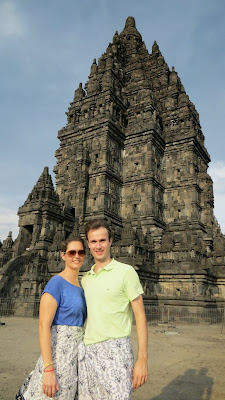After having seen the wilder parts of the Borneo jungles and
rural sites in the Mekong Delta or the rice fields of Bali, Ana and Simon felt
that they needed some new “big city vibes”. A very attractive flight offer then
suddenly put Hong Kong on the map – despite being almost four hours away from Singapore.
Ana and Simon went there for a three day weekend in September, leaving Singapore
Friday morning and returning Sunday.
Simon had already been to Hong Kong in 2007, returning from
his trip to Australia and New Zealand.
Back then, he had, however, only seen the big city life. Thus, he was more than
willing to explore Hong Kong “off the beaten
path”. Since Ana has some colleagues from Hong Kong and Simon some classmates,
they were well-advised what else to see beyond the famous Victoria Harbour.
Their first daytime excursion thus led them to the little village of Stanley
on the South Coast of Hong Kong Island. Within
less than 10km from the central district, there is a street market in a village
that almost seems to have some type of Mediterranean flair. Ana and Simon
really enjoyed strolling the alleys of the street market, stop for a coke and
later lunch with some beers while looking at the piers and enjoying 30 Csunshine.
Obviously, you cannot ignore that you are in one of the most densely-populated
regions of the planet – there were big condominium buildings somewhat
destroying the views of the country side but as long as they were in the back
and out of the view, the impression of a Mediterranean fishermen village held
up.
 |
| Hong Kong - really? Yes, the Southern part of HK Island |
 |
| Almost Mediterranean feel |
Apparently, it gets even more original than that if you go
to one of the 200 islands or to explore the “New
Territories” (the mainland part of Hong Kong) on hiking trail. Unfortunately, Ana and Simon
did not have the time to see the beaches or mountain regions there.
Other than the “not-expected” small-town vibe, Hong Kong obviously offers a lot of big-city charm. Ana
and Simon headed to the Victoria
Peak, the famous hill
that provides breathtaking views over the harbour and the financial district of
Hong Kong. It is incredible to see this place which has the largest number of
skyscrapers in the world. As an international metropolis, Hong
Kong also offered some great restaurants where Ana could indulge
in mix of Western and Easter cuisine, either with nice views or with a
prohibition style atmosphere and the most interesting drink selection. They
even met with another INSEAD student and friends and partied one night in Hong Kong among many expats and Chinese alike.
 |
| View from a restaurant with delicious food |
 |
| Dumplings at their best |
 |
| Peking duck |
 |
| The Bank of China building in the financial district |
 |
| Ana and Simon at Victoria Peak |
 |
| View of Victoria Harbour without tourists |
Singapore and Hong Kong are quite alike in many aspects - both city states, both part of the "tiger states" of economic development in the 1970s to 1990s, both former British colonies with a predominantly Chinese cultural influence. The main difference is Hong Kong's proximity to China which makes the Chinese influence much more pronounced. Despite the fact that Hong Kong still has a currency and passports of their own, the city was always considered as a part of China whereas Singapore was "the little red dot" at the end of the Malaysian peninsula. All in all, Ana and Simon had the
feeling that Hong Kong had somewhat of a more
“real” city feeling and was a great getaway weekend, adding to the lists of South East
Asian metropolis places.





































